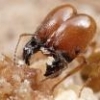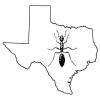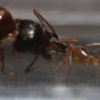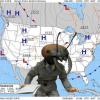- Formiculture.com
- Forums
- Gallery
- Members
- Member Map
- Chat

Finding Pheidole pilifera
Started By
Salmon
, Nov 28 2015 8:15 AM
38 replies to this topic
#1
 Offline
-
Posted November 28 2015 - 8:15 AM
Offline
-
Posted November 28 2015 - 8:15 AM
Hi, new member here.
I keep a number of insect species but I've never really made a serious effort at an ant colony. I've always been fascinated by ant genera like Pheidole that have dramatically different castes of workers to do different jobs, but I assumed that none of these species occured in my area and it's illegal to keep nonnative species. But I just learned that one species, Pheidole pilifera, does occur in massachusetts! And so next summer I'm really hoping to be able to collect a queen or small colony. But it seems that it won't be easy- I understand that they're very small and inconspicuous, and that the distinctive majors never leave the nest and the minor workers are difficult to tell from other ants. The information that I've managed to gather is that they build small anthills, live in open, sunny habitats like grasslands, and prefer sandy soil.
So, I would like to know some info about them from anyone who has experience with this genus or better yet this particular species:
What features can you use to tell them apart from other ants?
How large are their colonies?
What do their anthills and habitat look like? (If anyone has pictures that would be useful)
Are they common? If you have suitable habitat are you likely to find them?
And, most importantly, I would like to know at what time of year and time of day do the alates swarm at this latitude... And if they fly at night and could be collected in their habitat using a light sheet?
It would be really useful if anyone from Massachusetts could give me an exact location though I doubt it's going to happen.
Also, it would be even more useful if someone could tell me I'm overthinking this, and that they're actually easier to locate than I've led myself to believe!
Thanks in advance
I keep a number of insect species but I've never really made a serious effort at an ant colony. I've always been fascinated by ant genera like Pheidole that have dramatically different castes of workers to do different jobs, but I assumed that none of these species occured in my area and it's illegal to keep nonnative species. But I just learned that one species, Pheidole pilifera, does occur in massachusetts! And so next summer I'm really hoping to be able to collect a queen or small colony. But it seems that it won't be easy- I understand that they're very small and inconspicuous, and that the distinctive majors never leave the nest and the minor workers are difficult to tell from other ants. The information that I've managed to gather is that they build small anthills, live in open, sunny habitats like grasslands, and prefer sandy soil.
So, I would like to know some info about them from anyone who has experience with this genus or better yet this particular species:
What features can you use to tell them apart from other ants?
How large are their colonies?
What do their anthills and habitat look like? (If anyone has pictures that would be useful)
Are they common? If you have suitable habitat are you likely to find them?
And, most importantly, I would like to know at what time of year and time of day do the alates swarm at this latitude... And if they fly at night and could be collected in their habitat using a light sheet?
It would be really useful if anyone from Massachusetts could give me an exact location though I doubt it's going to happen.
Also, it would be even more useful if someone could tell me I'm overthinking this, and that they're actually easier to locate than I've led myself to believe!
Thanks in advance
#2
 Offline
-
Posted November 28 2015 - 1:57 PM
Offline
-
Posted November 28 2015 - 1:57 PM
I don't live in that area, nor that I am familiar with that species. However, I think the Pheidole majors do leave the nest. They go out to assist if there is large size food or fighting (attack and defend). Anyways, good luck finding one though.
#3
 Offline
-
Posted November 28 2015 - 9:46 PM
Offline
-
Posted November 28 2015 - 9:46 PM
I live in the suburbs of Chicago. Even though I'm far from you we share lots of species as our climates are quite similar. I can tell you that I have not yet found a Pheidole queen or colony of any species. I have been trying for almost 3 years know. I don't doubt they exist, I just imagine they are super rare. Good luck to you though. If I find a colony or queen I will let you know.
- nightxwolf88 likes this
Currently Keeping:
Trachymyrmex septentrionalis
Pheidole pilifera
Forelius sp. (Monogynous, bicolored) "Midwestern Forelius"
Crematogaster cerasi
Pheidole bicarinata
Aphaenogaster rudis
Camponotus chromaiodes
Formica sp. (microgena species)
Nylanderia cf. arenivega
#4
 Offline
-
Posted November 29 2015 - 6:38 AM
Offline
-
Posted November 29 2015 - 6:38 AM
Here's the queen spotting data I have collected that might help you.
Species Year Month Week Day Time of Day State City/Locale ------------------------------------------------------------------------------------------- Pheidole pilifera 2008 6 29 day NJ Somerdale Pheidole pilifera 2008 7 6 night Pheidole pilifera 2009 7 14 NJ Somerdale Pheidole pilifera 2012 6 4 IN Pheidole pilifera 2012 7 4 day NJ Monmouth County Pheidole pilifera 2013 8 1 NJ Pheidole sp. 2008 6 29 NJ
- AntsTexas, Technomyrmex and Chickalo like this
#5
 Offline
-
Posted November 29 2015 - 7:30 AM
Offline
-
Posted November 29 2015 - 7:30 AM
That's good to know that majors do leave the nest. I suppose putting food right next to a possible nest would bring them out so they could be positively identified. It also seems like the long, clubbed antennae on the minors are distinctive.
Hmm so according to that chart, in New Jersey they emerge any time in the summer... Looks like the best time to look for me would be july.
Hmm so according to that chart, in New Jersey they emerge any time in the summer... Looks like the best time to look for me would be july.
#6
 Offline
-
Posted May 18 2016 - 3:42 PM
Offline
-
Posted May 18 2016 - 3:42 PM
I found some on a sandy roadside within walking distance from my house! I was fishing for tiger beetle larvae when I noticed that the ants coming from a few of the nearby "L. neoniger" nests were unusually small. I noticed that they resembled tiny, reddish brown pavement ants with long, clubbed antennae- and when I fed them a dead cricket the majors came out!
#7
 Offline
-
Posted May 18 2016 - 8:25 PM
Offline
-
Posted May 18 2016 - 8:25 PM
I found some on a sandy roadside within walking distance from my house! I was fishing for tiger beetle larvae when I noticed that the ants coming from a few of the nearby "L. neoniger" nests were unusually small. I noticed that they resembled tiny, reddish brown pavement ants with long, clubbed antennae- and when I fed them a dead cricket the majors came out!
That is incredible luck. I am extremely jealous of you. ![]() The trick now is collecting them.
The trick now is collecting them.
Currently Keeping:
Trachymyrmex septentrionalis
Pheidole pilifera
Forelius sp. (Monogynous, bicolored) "Midwestern Forelius"
Crematogaster cerasi
Pheidole bicarinata
Aphaenogaster rudis
Camponotus chromaiodes
Formica sp. (microgena species)
Nylanderia cf. arenivega
#8
 Offline
-
Posted May 19 2016 - 2:22 PM
Offline
-
Posted May 19 2016 - 2:22 PM
Yeah, I definitely don't want to destroy a nest (or the nest, I tried to find more but it's like finding a needle in a haystack of labor day ants), but I don't think it'll be easy to find a queen either. Since I know what they and their nests look like now, maybe I'll try to find more nests in a better location.
That is incredible luck. I am extremely jealous of you.
I found some on a sandy roadside within walking distance from my house! I was fishing for tiger beetle larvae when I noticed that the ants coming from a few of the nearby "L. neoniger" nests were unusually small. I noticed that they resembled tiny, reddish brown pavement ants with long, clubbed antennae- and when I fed them a dead cricket the majors came out!The trick now is collecting them.
Here's a picture of them:

- Chickalo likes this
#9
 Offline
-
Posted May 23 2016 - 1:33 PM
Offline
-
Posted May 23 2016 - 1:33 PM
So, I ended up finding another nest. When I first found it a couple days ago, it was obviously much smaller, since there were only two small hills with very few ants going in and out. I saw them being harassed by both labor day and pavement ants, and when I tried to feed them a walnut piece it was swarmed by pavement ants who intimidated them away from their own nest entrance. Then they abandoned the old nest entrances and built new ones several inches away. Today, checked on them and discovered no Pheidole... Except for one dead major being carted off by a labor day ant. Additionally, the nest is in a very bad location where a single stray car tire could obliterate it. They're a small colony that's definitely not doing too good and I doubt they'll survive much longer, so I see anything wrong with collecting them. That's assuming they're even still there and the other ants didn't just kill them all today...
Except for one problem: the soil they are in is extremely rocky, and very difficult to dig through. There's no way I could excavate the nest intact or in a timely fashion, and I'm not sure exactly how big the nest is or what Pheidole nests are shaped like. What should I do?
Except for one problem: the soil they are in is extremely rocky, and very difficult to dig through. There's no way I could excavate the nest intact or in a timely fashion, and I'm not sure exactly how big the nest is or what Pheidole nests are shaped like. What should I do?
#10
 Offline
-
Posted May 23 2016 - 1:40 PM
Offline
-
Posted May 23 2016 - 1:40 PM
So, I ended up finding another nest. When I first found it a couple days ago, it was obviously much smaller, since there were only two small hills with very few ants going in and out. I saw them being harassed by both labor day and pavement ants, and when I tried to feed them a walnut piece it was swarmed by pavement ants who intimidated them away from their own nest entrance. Then they abandoned the old nest entrances and built new ones several inches away. Today, checked on them and discovered no Pheidole... Except for one dead major being carted off by a labor day ant. Additionally, the nest is in a very bad location where a single stray car tire could obliterate it. They're a small colony that's definitely not doing too good and I doubt they'll survive much longer, so I see anything wrong with collecting them. That's assuming they're even still there and the other ants didn't just kill them all today...
Except for one problem: the soil they are in is extremely rocky, and very difficult to dig through. There's no way I could excavate the nest intact or in a timely fashion, and I'm not sure exactly how big the nest is or what Pheidole nests are shaped like. What should I do?
Nope. Back in San Diego (California), I tried digging up small Pheidole colonies and even they were too deep. It was even harder since the soil was hard (and rocky) like the one you found them in. I found they dug much deeper than I thought, but I only tried getting them because construction was soon to bulldoze over them. I never managed to even get any of them.
You could try this idea. it never worked for me. And it doesn't sound like a good area to do it for you, if its right by the road. Might still work, just not as good. But, there is a "trick" where you can dig a hole, flood it with a bit of water (not too much) and put something over it (like a large flat rock). Come back in a few days to a week, and in theory, there is a chance they could bring the queen and all the brood to nest under the rock. Because, when its sunny, they'll go underneath it for the warmth. I never had luck doing that, though. Maybe you could. Works (in theory) for a lot of ant species.
You'll find you'll have to make a HUGE hole just to get them other than that. They nest really deep. I went down about 10 inches (before it was just too hard to keep digging) and never even got to their brood chambers, and it was a small looking colony. But, maybe Pheidole pilifera are different, but that was my experience with the ones in southern California.
Edited by Vendayn, May 23 2016 - 1:41 PM.
#11
 Offline
-
Posted May 23 2016 - 2:31 PM
Offline
-
Posted May 23 2016 - 2:31 PM
i have some pheidole pallidula over here in west texas
Ant Queens found:
Solenopsis Invicta, Solenopsis xyloni, Brachymyrmex depilis/Sp, Myrmecocystus Mimicus, Pogonomyrmex barbatus,
Forelius pruinosus, Camponotus sayi, Dorymyrmex insanus, crematogaster ashmeadi,
----------------------------------------
Ant Queens i have going right now:
camponotus sayi, solenopsis invicta, Myrmecocystus Mimicus, Forelius pruinosus
Pogonomyrmex barbatus, and some others (no i.d.)
---------------------------------------
YouTube: AntsTexas
Facebook: https://www.facebook.com/cdockray1
Facebook page: AntsTexas
#12
 Offline
-
Posted May 23 2016 - 4:07 PM
Offline
-
Posted May 23 2016 - 4:07 PM
The rock trick definitely sounds worth a shot! There's rocks all over that roadside anyway.
#13
 Offline
-
Posted May 23 2016 - 4:21 PM
Offline
-
Posted May 23 2016 - 4:21 PM
Nice! I Live in Mass as well and never noticed these before... I did notice on some hiking over the weekend near the house in an abandoned granite quarry, there were the common reddish brown Lasius nests everywhere, and a handful of much smaller reddish ants. Never thought to take a closer look at them until now ![]()
#14
 Offline
-
Posted May 24 2016 - 3:32 AM
Offline
-
Posted May 24 2016 - 3:32 AM
Question about the rock trick: do you dig the hole and add the rock directly on top of the nest, or next to it? Seems like either way might work.
Edited by Salmon, May 24 2016 - 3:32 AM.
#15
 Offline
-
Posted May 24 2016 - 11:30 AM
Offline
-
Posted May 24 2016 - 11:30 AM
Hmm, I've always just dug the hole and put the rock directly on top of the nest. You could do both and see what works better.
#16
 Offline
-
Posted May 29 2016 - 11:26 AM
Offline
-
Posted May 29 2016 - 11:26 AM
I think I've found my target! It's absolutely minuscule, and there's no hill or other visible signs of its presence. Just a small, inconspicuous hole hidden at the base of a plant with an ant going in or out every few minutes. I would never have known it was there if I didn't see a worker carrying a seed and follow it back. It's in much softer soil with almost no rocks, which should be very easy to dig through! Even if they do nest deep, I have a hard time believing that a single shovel scoop wouldn't be enough to capture the whole colony.
#17
 Offline
-
Posted May 29 2016 - 7:58 PM
Offline
-
Posted May 29 2016 - 7:58 PM
I think I've found my target! It's absolutely minuscule, and there's no hill or other visible signs of its presence. Just a small, inconspicuous hole hidden at the base of a plant with an ant going in or out every few minutes. I would never have known it was there if I didn't see a worker carrying a seed and follow it back. It's in much softer soil with almost no rocks, which should be very easy to dig through! Even if they do nest deep, I have a hard time believing that a single shovel scoop wouldn't be enough to capture the whole colony.
You might have better luck than I did. Plus it didn't help the Pheidole I tried to get, were in hard dirt that was way too rocky.
I recommend a sifter, and sift through the dirt and ants. Unless you already planned that. Otherwise the queen (which will be pretty small), will be hard to find in the dirt you dig up (if you are able to get her at all).
If they are like the native Pheidole here though, they are really easy to keep. I never had anything but workers/soldiers, but they are hardier than even Solenopsis are. I have Pheidole megacephala (which actually dig shallow nests), and they are easy, but they are more of a tropical species. And they aren't native.
I always wanted one of the tiny native Pheidole that are out in the desert, those are my favorite of the native Pheidole. But, never had luck getting them. And I'm not too big a fan of the bigger Pheidole, like Pheidole hyatti. They aren't as easy to keep as the tiny ones out in the desert. Maybe someone this year, locally, will have small native Pheidole for sell ![]()
I'll be first to buy. ![]()
Edited by Vendayn, May 29 2016 - 7:59 PM.
#18
 Offline
-
Posted June 12 2016 - 10:02 AM
Offline
-
Posted June 12 2016 - 10:02 AM
Pheidole pilifera seem to only fly immediately after a summer rainfall that occurs in the afternoon. Immediately as in water is still dripping from the trees. I base that off of experience, because the species is fairly common where I used to live in NJ. Here's a video I took of a flight, just so you know what to look for:
https://www.youtube....h?v=dmNAdK3l_8Q
The queens end up in swimming pools a lot, and you can find them wandering on sidewalks after their flight. They're fairly easy to raise too. Good luck
Here's a journal on another forum where I had a colony of these:
http://antfarm.yuku....=1#.V12jrfkrKUl
#19
 Offline
-
Posted June 28 2016 - 7:22 AM
Offline
-
Posted June 28 2016 - 7:22 AM
Oh, ok. Afternoon. This morning it rained, and I went down to a good spot I found with 9 or 10 nests expecting to see some activity but there wasn't any.
They're located right next to a small pond, so I imagine that some of them will wind up in there.
They're located right next to a small pond, so I imagine that some of them will wind up in there.
#20
 Offline
-
Posted June 28 2016 - 7:28 AM
Offline
-
Posted June 28 2016 - 7:28 AM
NWS is predicting thunderstorms this afternoon in MA, so may get lucky ![]()
Edited by noebl1, June 28 2016 - 7:28 AM.
0 user(s) are reading this topic
0 members, 0 guests, 0 anonymous users



















